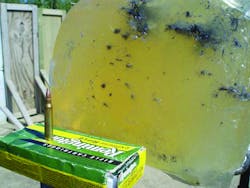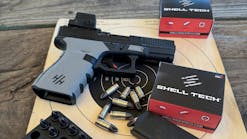History is not linear; it has a habit of circling back on itself. In the 1930s, violent bank robbery gangs armed with military automatic rifles and submachine guns murdered citizens and law enforcement officers, terrorizing the nation in the commission of their crimes. John Dillinger, Baby Face Nelson, Bonnie and Clyde -- to name a few of the hard core criminals -- were finally brought to their end by lawmen using savvy tactics and armed to meet the threat.
The criminals had access to body armor of the day and were often located inside vehicles or behind hard cover at extended distances. Understanding that their revolvers and pistols were not up to the fight, law officers acquired Browning automatic rifles, Remington Model 8s, and Winchester .351 Self Loaders as their patrol rifles. These men knew what they were facing, and armed themselves with the necessary tools to win against deadly offenders.
Modern-day gang busters
We have come full circle, as today we face not only the traditional criminal threats, equal in every way to the bad old days, but also the threat of terrorism as exemplified by the Beslan, Russia and Mumbai, India attacks. The rifle has returned to front duty in law enforcement agencies across the nation and is now standard gear -- fully integrated into training programs and deployed on every shift. Officers armed with patrol rifles have successfully defended themselves and citizens during violent attacks and brought a stop to offenders' deadly crimes.
Given the strong basis for acceptance of the patrol rifle, here are my thoughts on key elements of a comprehensive patrol rifle training and deployment program. Selection of the approved firearm, caliber, ammunition type, costs, training and policy all come into play.
Selection of weapon type:
A number of long guns could meet the patrol rifle function, but factors in selection include:
- Adjustable stock option to allow officers of all sizes to attain a proper shoulder mount and cheek weld
- Length to fit in an overhead or interior mounted rack
- Ambidextrous safety/selector for left- and right-handed officers
- Integral mounting rail system to accommodate red dot or magnified optics
- Iron sight system to back up optics
- Attachment points for tactical sling and light
- Readily availablereplacement parts and armorer classes
- Availability ofsubcaliber .22 or pistol caliber training conversion unitsshould range access be limited to pistol caliber back stops
- Previous experience and familiarity with the rifle type
The AR-15/M-16 system
The predominate rifle in use today is the AR-15/M-16 type system. Rarely do we see officers armed with anything else. The handling qualities, available accessories and easy adaptability to officers of all sizes make this firearm first in consideration. Many of our police officers are military veterans who have been trained on the M-16A2/M4.
The M-16, first produced by Colt in the 1960s, is currently offered by a host of other manufacturers in a multitude of versions. Smith & Wesson, Ruger and Remington have added versions to their product lines. High quality rifles are being produced by Mark LaRue of LaRue Tactical, Greg Sullivan of SLR15, and Barrett to name a few I have tested at length.
For those starting a patrol rifle program or seeking to add rifles where money is tight, original Colt M-16A1 rifles are available though the U.S. Military Surplus LESO 10-33 program at well under $100. Compared to new manufactured rifles and carbines in the $800-plus range, it is a true bargain. These are full auto capable rifles that can be converted to semi-auto function for less than $20.
In the early years of the 10-33 program, only a limited number of rifles could be acquired per agency. Today, an agency can order the same number of rifles as sworn officers.
Barrel twist rates & ammo options
Ammo and barrels are not all the same -- this is important. Know your threat environment and choose your ammo accordingly. No one bullet type can do it all.
The AR-15/M-16 fired the .223/5.56 mm round. In this caliber selection there exists a wide variety of bullet choices to meet tactical needs. Entire volumes have been written on bullet selection, but boiling it down to the bottom line, if only one type is to be authorized I strongly recommend a barrier penetrator type. Corbon DPX, Black Hills TSX and other brands loaded with the excellent Barnes X bullets rank at the top of the list. Federal Tactical bonded .223, Remington Bonded PSP and Hornady TAP penetrators are also available. Make sure the bullet is a "bonded" or solid projectile, as labels can be confusing. Barrier penetrator ammunition is standard street issue to agents of the FBI and DEA. Both of these respected agencies have done extensive testing to prove the need. For police patrol/SWAT functions where offenders are inside vehicles and behind cover, barrier penetrators will be most effective where fast fragmenting polymer tip, soft point and full metal jacket bullets will fail to make it through to deliver a fight stopping wound.
Barrels and bullets
Coupled with ammunition selection, a technical barrel issue must be reviewed. As stated, the AR-15/M-16 system is chambered for the most common patrol rifle caliber, the .223 Remington/5.56 x .45 mm NATO round. Rifles can be chambered for either .223 or 5.56. The commercial .223 can be fired with no issue in a military 5.56 chamber, but not the reverse. Be certain that your patrol rifle barrel has a true 5.56 mm chamber to prevent function problems that often occur when 5.56 mm ammo is fired in a .223 chamber.
In addition to projectile construction and type, bullet weight must also be matched to the barrel twist rate. Twist rate is the distance in inches the bullet must travel to complete one full turn. The rule is that heavier bullets of the same caliber must spin faster to stabilize in flight.
The early M-16 A1 has a "slower" twist rate of 12 inches for a 55 grain bullet. Therefore the bullet made a full 360-degree rotation in 12 inches of barrel to stabilize the bullet in flight. Any bullet weight in excess of 60 grains fired in a 1/12-inch twist barrel typically will not stabilize and will begin to yaw or wobble in flight. Upon hitting the target, the bullet turns sideways on impact, creating what is called a "keyhole" (as seen in Photo 5 on Page 42).
Other than the surplus M-16s, almost all AR type barrels today are manufactured with either a 1/7 or 1/9-inch twist barrel rate. While they generally will stabilize bullet weights of 50 to 77 grains, go with a 1/7 if you intend to use the heaviest bullets. Be sure when ordering your patrol rifle that you know what twist rate the manufacturer uses. Understand that the slower twist rate LESO 10-33 M-16 A1s limit bullet weight to under 60 grains, and restrict ammo choices to the lighter weight bullets.
Exotic additions go mainstream
To create the functional patrol rifle system requires a few additions to the basic rifle. What used to be exotic accessories are now mainstream items. The most basic additions include a tactical sling that allows the patrol rifle to be carried close to the body and ready for immediate use. The sling should be capable of retaining the rifle close and tight to the officer should he or she need to transition to empty hands, electric stun device or handgun. The best sling designs offer fast adjustment and allow firing from either shoulder. The Spec.-Ops Patrol and Viking VTAC tactical slings are examples I use daily.
Rifle mounted lights are another component that come in many forms and mounting solutions for the patrol rifle. Surefire and Streamlight are among the companies offering a number of possibilities. Having used these for years in all weather and conditions, I know they work on demand. The cost may be higher initially, but they hold up and are backed by solid warranties. Features to look for in any light and mount include: lightweight, powerful, long battery life, shockproof and easily accessed, positive on-off switching.
There are so many options out there. Use this as a starting point for discussion to make your choices. Whichever gear you choose, do so for the right reasons and train with it regularly.



